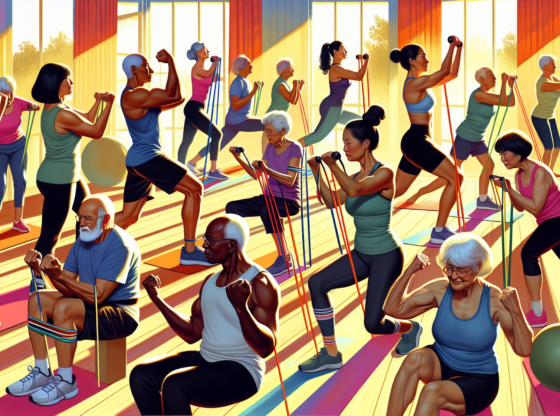Are you a senior looking to keep your strength and mobility in check? Resistance band exercises can help. These exercises are low-impact, easy to start, and incredibly beneficial. In this article, you’ll learn which resistance band exercises for seniors can enhance your strength, improve your balance, and support your overall health.
Key Takeaways
- Resistance band exercises offer seniors improved muscle strength, flexibility, and balance, reducing the risk of falls and injuries while being kind to joints.
- Key exercises such as bicep curls, glute bridges, seated rows, squats, lateral raises, chest presses, and leg presses provide a full-body workout beneficial for daily activities and overall health.
- Choosing the right resistance band (light to medium resistance, preferably with handles) and focusing on proper form, warm-ups, and consulting healthcare providers ensure a safe and effective exercise regimen for seniors.
Table of contents
- Key Takeaways
- Introduction
- Top Resistance Band Exercises for Seniors
- Benefits of Resistance Band Exercises for Seniors
- How to Choose the Right Resistance Bands for Seniors
- Precautions for Seniors Starting Resistance Band Exercises
- Sample 20-Minute Resistance Band Workout for Seniors
- Tips for Staying Motivated
- Summary
- Frequently Asked Questions
Introduction
For seniors, maintaining mobility and strength is more than a fitness goal—it’s a cornerstone of a vibrant and independent life. Regular low-impact exercises are not just kind to your joints but are crucial for managing arthritis symptoms and preserving joint health. As we enter our 50s and beyond, combatting age-related muscle loss becomes a priority, and resistance band exercises are a versatile and convenient ally in this battle. Some benefits of resistance band exercises for seniors include:
- Improved muscle strength and tone
- Increased flexibility and range of motion
- Enhanced balance and stability
- Reduced risk of falls and injuries
- Convenient and portable, can be done anywhere
- Suitable for all fitness levels
Incorporating resistance band exercises into your resistance training routine can help you stay active, independent, and healthy as you age.
With the promise of improved core strength, better balance, and a variety of resistance levels to suit your fitness journey, resistance bands are a practical tool for any senior looking to stay active at home.
Top Resistance Band Exercises for Seniors
Embarking on a new exercise regimen can be daunting, but with resistance bands, getting started is as simple as picking up a lightweight, easy-to-store tool that’s ready to transform your fitness routine. Let’s dive into the best resistance band exercises that can offer you a full-body workout, enhance your muscle strength, and bring a refreshing challenge to your workout routine.
Bicep Curls
Bicep curls with resistance bands, performed with elbows bent, aren’t just about looking good; they’re a functional exercise that tones and strengthens the arms, essential for lifting groceries or picking up grandchildren.
By integrating bicep curls into your workout routine, you’re not only targeting the muscles of the upper arm but also engaging your core and improving your overall muscle strength.
Glute Bridges
Glute bridges are a powerhouse of an exercise, targeting the muscles that are pivotal for your mobility and stability. As a senior, including this exercise in your regimen can lead to stronger glutes, hamstrings, and a more supportive lower back, translating to less pain and more functional movement in your daily life.
Seated Row
The seated row is a resistance band exercise that packs a punch for your upper body. By targeting your upper back, shoulders, and biceps, this exercise not only enhances muscle strength but also contributes to an upright posture, making daily activities like carrying and reaching much easier.
Squats
Squats are a fundamental exercise for any age, but for seniors, they’re essential for maintaining lower body strength and core stability. Incorporating resistance bands into your squats, starting from a proper squat position, adds that extra challenge to strengthen your major muscle groups and improve your functional fitness, which helps with balance and coordination — key components in preventing falls.
Lateral Raise
Lateral raises with resistance bands are all about enhancing upper body stability and shoulder strength. This exercise is particularly helpful for seniors, as it focuses on:
- Building the muscles around the shoulder blades
- Improving shoulder mobility
- Strengthening the deltoid muscles
- Enhancing posture and stability
These benefits are crucial for tasks ranging from lifting to waving hello, even as simple as putting your left foot forward.
Chest Press
Chest presses with resistance bands mimic the classic dumbbell chest press, allowing you to target the chest muscles without the need for heavy weights. Ideal for seniors, this exercise promotes upper body strength and can contribute significantly to your overall health and fitness.
Leg Press
Leg presses with resistance bands are a fantastic way to strengthen the front thigh muscles, supporting overall leg strength and stability. By sitting on a chair with your feet hip width apart and pressing forward against the band’s resistance, you engage various muscles in your legs, which is vital for maintaining mobility and reducing the risk of injury.
Benefits of Resistance Band Exercises for Seniors
While resistance band exercises are beneficial for all ages, they hold particular advantages for seniors. These exercises can help mitigate the natural muscle loss that comes with aging, providing a low-impact workout that’s gentle on the joints while still being effective at building muscle strength and improving joint health.
Low Impact
To start, one of the most significant benefits of resistance band exercises is their low-impact nature. They provide the resistance needed to build strength without putting undue stress on the joints, making them an excellent choice for seniors dealing with joint issues or arthritis. Additionally, resistance exercises like these band exercises can be easily adapted to various fitness levels and goals.
Versatility
Another feature is the versatility of resistance bands cannot be overstated. They can easily be integrated into various exercises. This allow you to target multiple muscle groups with a single piece of equipment. This adaptability makes them an ideal choice for seniors, as they can adjust the resistance levels to match their fitness level and progress over time.
Improved Balance and Stability
Improved balance and stability are crucial for preventing falls that is a common concern for seniors. Resistance band exercises engage stabilizing muscles, which contribute to better postural control and knee support, thereby reducing the risk of falls and related injuries.
How to Choose the Right Resistance Bands for Seniors
Selecting the right resistance band is essential for a safe and effective workout. Seniors should consider the band’s resistance level, comfort, and material to ensure the best fit for their needs, abilities, and to prevent injury.
Light to Medium Resistance
For seniors, starting with light to medium resistance bands is recommended to prevent strain and overexertion. These bands offer enough resistance to effectively strengthen muscles without the risk of injury, which is especially important for those new to strength training or recovering from an injury.
Bands with Handles
Bands with handles are often the best choice for seniors. They provide a more comfortable and secure grip, which is particularly beneficial for those with weaker hand strength or arthritis. Handles also offer a better range of motion for exercises, allowing for a more effective workout.
Material Considerations
When it comes to material, latex bands are known for their durability and elasticity. However, for seniors with latex allergies, non-latex bands made from medical-grade rubber are a safe and effective alternative.
Precautions for Seniors Starting Resistance Band Exercises
Before jumping into any new exercise program, seniors should take certain precautions to ensure safety and reduce the risk of injury. This is particularly important for those returning from injury or experiencing pain.
Consult Your Healthcare Provider
It’s critical for seniors to consult their healthcare provider before beginning any new exercise program, especially if they have pre-existing injuries or health conditions. This step ensures that the chosen exercises are safe and appropriate for their specific health needs.
Warm-Up Properly
To begin, warming up properly with light cardio exercise or dynamic stretches is essential to prepare the body for the upcoming physical activity. A good warm-up increases blood flow to the muscles and reduces the risk of injury.
Focus on Proper Form
Maintaining proper form during resistance band exercises, such as keeping your arms straight when required, is crucial for preventing injuries and ensuring the correct muscle mass is engaged.
Seniors should focus on controlling their movements throughout each exercise to minimize the risk of strain.
Sample 20-Minute Resistance Band Workout for Seniors
A well-rounded 20-minute resistance band workout for seniors should include a warm-up, main workout, and cool down. This structure ensures a balanced approach that prepares the body, challenges it during the workout, and aids in recovery afterward.
Warm-Up
Like we said before, starting with a warm-up that includes light cardio or dynamic stretches is the best way to prepare your body for the resistance band workout. This could be as simple as a brisk walk or gentle joint rotations to get the blood flowing and muscles ready for exercise. Once you’re warmed up, assume the appropriate starting position for each resistance band exercise.
Main Workout
The main workout can include a variety of resistance band exercises such as leg presses, calf presses, and bent-over rows. These exercises target different muscle groups, providing a comprehensive workout that challenges the whole body.
Cool Down
Finishing the workout with a cool-down is crucial for muscle recovery. Gentle stretching exercises help to relax the muscles, reduce stiffness, and promote overall recovery, setting you up for success in your next workout session.
Tips for Staying Motivated
Staying motivated can be challenging, but with the right strategies, seniors can maintain their exercise regimen and enjoy the benefits of an active lifestyle.
Here are some tips to help you stay on track with your fitness goals.
Set Realistic Goals
Firstly, it is important to set realistic goals is key to building strength and confidence gradually. Start with small, achievable targets and slowly increase the intensity and duration of your workouts. This approach helps prevent burnout and keeps you motivated to continue progressing.
Find a Workout Buddy
Secondly, find a workout buddy can provide motivation, enjoyment, and accountability. Exercising with a friend or family member makes the experience more social and enjoyable, and it can help you stick to your workout schedule.
Track Your Progress
And last but not least, track your progress is an effective way to stay motivated. Keep a record of your workouts, celebrate your achievements, and use tools like exercise apps to visualize your progress over time. This can provide a clear sense of accomplishment and inspire continued effort.
Summary
In conclusion, resistance band exercises offer seniors a flexible, low-impact, and effective way to maintain strength, mobility, and independence. By incorporating these exercises into a regular workout routine seniors can enjoy a higher quality of life and stay active and strong well into their later years. Remember, the key is to start slow, prioritize safety, and keep pushing forward—your body and mind will thank you for it.
Frequently Asked Questions
Seniors should perform resistance band exercises at least twice a week, as recommended by the American College of Sports Medicine and the American Heart Association, while paying attention to their body’s needs and including rest days for recovery.
Yes, resistance band exercises can greatly improve balance and stability in seniors by engaging and strengthening the core and stabilizing muscles. Try incorporating them into your routine for better balance!
Seniors should start with light to medium resistance bands to avoid strain, and gradually increase the resistance as strength improves. You’ve got this!
Yes, resistance bands are safe and gentle on the joints, providing adjustable resistance for seniors with arthritis. It’s important to consult with a healthcare provider before starting any new exercise routine.
If you experience pain during resistance band exercises, it’s crucial to stop immediately and consult your healthcare provider to ensure you’re not injuring yourself. Adjust your exercise program as necessary to prevent further discomfort.



